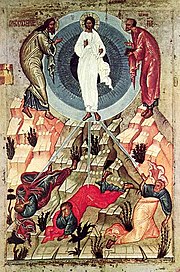묵상
| 이 문서는 영어 위키백과의 Contemplation 문서를 번역하여 문서의 내용을 확장할 필요가 있습니다. |
묵상(默想, 영어: contemplation)은 특정 대상을 깊게 생각하는 행위이며 종교적인 관점에서 묵상은 기도 및 명상을 수행하는 방법 중 하나이다.
역사[편집]
묵상은 플라톤 철학의 중요한 부분이었다. 플라톤은 묵상을 통해 영혼이 좋은 형태 나 다른 신성한 형태의 지식으로 올라갈 것이라고 생각했다. Plotinus as a (neo) Platonic 철학자는 또한 henosis에 도달하기위한 가장 중요한 구성 요소로서 숙고를 표현했다. 플롯 티 누스 (Plotinus)에게 하나님, 모나드 또는 하나라는 비전을 경험하는 것이 가장 큰 묵상이었다. Plotinus는 Enneads의 작품에서이 묵상의 경험을 묘사한다. 그의 학생 반암 (Porphyry)에 따르면 플롯 티 누스 (Plotinus)는 그가 4 번이 경험을 했다고 말했다. Plotinus는 Enneads 6.9.xx에서 자신의 묵상에 대한 경험을 썼다 ....
개요[편집]
묵상이라는 단어는 라틴어 단어 contemplatio에서 파생된다. 그것의 뿌리는 또한 라틴어 단어 templum, 후원의 받음을 위해 봉헌 된 땅 조각, 또는 예배를위한 건물, Proto-Indo-European 기초 가 되었고 유럽에서 기초 -"스트레칭 "- 따라서 제단 앞의 정리 된 공간을 가리킨다. 라틴어 단어 contemplatio는 그리스어 θεωρία (theòría)를 묵상의 의미를 번역하는 데 사용되었다.
명상과 묵상의 차이점[편집]
기독교에서 묵상이란 살아있는 현실로서의 하느님에 대한 인식을 향한 내용없는 마음을 의미한다. 이것은 어떤면에서 동양 종교에서 기도를 하는 행위인 사마 디 (samadhi)라고 불리는 것에 해당한다. 한편 서양 교회에서 수세기 동안 묵상은 이그나 티아 운동이나 개종자와 같이 성서적 장면을 시각화하는 것과 같은 것에서 활발한 수행과정으로 연습을 언급했다.
정신 분야 전문가는 "성경의 내용을 듣고 "마음의 귀"는 마치 그 또는 그녀가 하나님과 대화하고있는 것처럼, 그리고 하나님은 토론 할 주제를 제안하고 계신다.라고 묵상의 목표를 제시했다[출처 필요]
토마스 아퀴나스는 묵상에 관하여 다음과 같이 썼다. "인간 공동체의 유익을 위해서는 묵상의 삶에 헌신하는 사람들이 있어야한다." 토마스 아퀴나스를 연구한 독일인 기독교 철학자 조셉 피퍼(Josef Pieper)는 다음과 같이 논평했다. "인간 사회의 한가운데에 보존되어있는 진실성은 한 번에 동시에 쓸모 없으며 모든 가능한 사용에 대한 척도가 된다. 따라서 진실을 유지하는 것도 고려 중이다. 눈에 보이는것에서 사라지면 이때 삶의 모든 실제 행동에 의미를 부여합니다. "[출처 필요]
같이 보기[편집]
熟考
| ウィキペディアには「熟考」という見出しの百科事典記事はありません(タイトルに「熟考」を含むページの一覧/「熟考」で始まるページの一覧)。 代わりにウィクショナリーのページ「熟考」が役に立つかもしれません。 |
関連項目[編集]
中文維基百科Facebook粉絲專頁正式上線,邀請大家一同關注。 | [关闭] |
默觀[编辑]
| 此條目需要擴充。 (2011年7月10日) |
| 此條目没有列出任何参考或来源。 (2011年7月10日) |
| 秘傳基督教系列 |
| 基督教神秘主義 |
|---|
 |
默觀(英語:Contemplation),基督教術語,意思是透過祈禱或默想,來感受到上帝的力量,是一種對於上帝,單純的直覺凝視,因此能夠看見上帝的神聖本質,在神秘主義與靈修有著重要的地位。
字根[编辑]
它的字根來自於拉丁語:contemplatio,意思是觀看、持續的注目。拉丁語:contemplatio則源自於拉丁語:templum,它是在占卜之前,由占卜者劃出的空間,讓他可以在其中觀察神靈的力量。這個字譯自於希臘語:θεωρία(Theoria),有割開、切斷的意思,是神聖與平凡人世之間的界線。
参见[编辑]
| 这是一篇與天主教相關的小作品。你可以通过编辑或修订扩充其内容。 |
Contemplation
In a religious context, the practice of contemplation seeks a direct awareness of the divine which transcends the intellect, often in accordance with prayer or meditation.[1]
Etymology[edit]
The word contemplation is derived from the Latin word contemplatio, ultimately from the Latin word templum, a piece of ground consecrated for the taking of auspices, or a building for worship. The latter either derives from the Proto-Indo-European root *tem- ("to cut"), on notion of "place reserved or cut out", or from the root *temp- ("to stretch, string"), thus referring to a cleared (measured) space in front of an altar.[2][3] The Latin word contemplatio was used to translate the Greek word θεωρία (theōría).
Greek philosophy[edit]
Contemplation was an important part of the philosophy of Plato; Plato thought that through contemplation, the soul may ascend to knowledge of the Form of the Good or other divine Forms.[4]
Plotinus as a (neo)Platonic philosopher also expressed contemplation as the most critical of components for one to reach henosis. [mystical "oneness", "union" or "unity"]
To Plotinus the highest contemplation was to experience the vision of God, the Monad or the One. Plotinus describes this experience in his works the Enneads. According to his student Porphyry, Plotinus stated that he had this experience of God four times.[5] Plotinus wrote about his experience in Enneads 6.9.
Judaism[edit]
A number of sources have described the importance of contemplation in Jewish traditions, especially in Jewish meditation.[6] Contemplation was central to the teaching of the Jewish philosopher Maimonides, who taught that contemplating God involves recognizing moral perfection, and that one must interrupt contemplation to attend to the poor.[7] Contemplation has also been central to the Musar movement.[8]
Islam[edit]
In Islamic tradition, it is said that Muhammad would go into the desert, climb a mountain known as Mount Hira, and seclude himself from the world. While on the mountain, he would contemplate life and its meaning.[9]
Bahai Faith[edit]
Baha'u'llah and Abdu'l-Baha wrote about contemplation and meditation in regards to reflecting on beauty, the Kingdom of God, science, and the arts. Abdu'l-Baha stated that "the sign of the intellect is contemplation and the sign of contemplation is silence... he cannot both speak and meditate".[10]
Christianity[edit]
In Eastern Christianity, contemplation (theoria) literally means to see God or to have the Vision of God.[note 1] The state of beholding God, or union with God, is known as theoria. The process of Theosis which leads to that state of union with God known as theoria is practiced in the ascetic tradition of Hesychasm. Hesychasm is to reconcile the heart and the mind into one thing (see nous).[note 2]
Contemplation in Eastern Orthodoxy is expressed in degrees as those covered in St John Climacus' Ladder of Divine Ascent. The process of changing from the old man of sin into the newborn child of God and into our true nature as good and divine is called Theosis.
This is to say that once someone is in the presence of God, deified with him, then they can begin to properly understand, and there "contemplate" God. This form of contemplation is to have and pass through an actual experience rather than a rational or reasoned understanding of theory (see Gnosis). Whereas with rational thought one uses logic to understand, one does the opposite with God (see also Apophatic theology).
The anonymously authored 14th century English contemplative work The Cloud of Unknowing makes clear that its form of practice is not an act of the intellect, but a kind of transcendent 'seeing,' beyond the usual activities of the mind - "The first time you practice contemplation, you'll experience a darkness, like a cloud of unknowing. You won't know what this is... this darkness and this cloud will always be between you and your God... they will always keep you from seeing him clearly by the light of understanding in your intellect and will block you from feeling Him fully in the sweetness of love in your emotions. So be sure to make your home in this darkness... We can't think our way to God... that's why I'm willing to abandon everything I know, to love the one thing I cannot think. He can be loved, but not thought."[14]
Within Western Christianity contemplation is often related to mysticism as expressed in the works of mystical theologians such as Teresa of Avila and John of the Cross as well as the writings of Margery Kempe, Augustine Baker and Thomas Merton.[15]
Dom Cuthbert Butler notes that contemplation was the term used in the Latin Church to refer to mysticism, and "'mysticism' is a quite modern word".[16]
Meditation[edit]
In Christianity, contemplation refers to a content-free mind directed towards the awareness of God as a living reality.[citation needed] This corresponds, in some ways, to what in Eastern religion is called samadhi.[17][18] Meditation, on the other hand, for many centuries in the Western Church, referred to more cognitively active exercises, such as visualizations of Biblical scenes as in the Ignatian exercises or lectio divina in which the practitioner "listens to the text of the Bible with the 'ear of the heart', as if he or she is in conversation with God, and God is suggesting the topics for discussion."[19]
In Catholic Christianity, contemplation is given importance. The Catholic Church's "model theologian", St. Thomas Aquinas wrote: "It is requisite for the good of the human community that there should be persons who devote themselves to the life of contemplation." One of his disciples, Josef Pieper commented: "For it is contemplation which preserves in the midst of human society the truth which is at one and the same time useless and the yardstick of every possible use; so it is also contemplation which keeps the true end in sight, gives meaning to every practical act of life."[20] Pope John Paul II in the Apostolic Letter "Rosarium Virginis Mariae" referred specifically to the catholic devotion of the Holy Rosary as "an exquisitely contemplative prayer" and said that "By its nature the recitation of the Rosary calls for a quiet rhythm and a lingering pace, helping the individual to meditate on the mysteries of the Lord's life as seen through the eyes of her who was closest to the Lord. In this way the unfathomable riches of these mysteries are disclosed."[21]
According to Aquinas, the highest form of life is the contemplative which communicates the fruits of contemplation to others, since it is based on the abundance of contemplation (contemplari et contemplata aliis tradere) (ST, III, Q. 40, A. 1, Ad 2).
See also[edit]
Notes[edit]
- ^ Metropolitan Hierotheos Vlachos: "The vision of the uncreated light, which offers knowledge of God to man, is sensory and supra-sensory. The bodily eyes are reshaped, so they see the uncreated light, "this mysterious light, inaccessible, immaterial, uncreated, deifying, eternal", this "radiance of the Divine Nature, this glory of the divinity, this beauty of the heavenly kingdom" (3,1,22;CWS p.80). Palamas asks: "Do you see that light is inaccessible to senses which are not transformed by the Spirit?" (2,3,22). St. Maximus, whose teaching is cited by St. Gregory, says that the Apostles saw the uncreated Light "by a transformation of the activity of their senses, produced in them by the Spirit" (2.3.22).[12]
- ^ pelagia.org: "Stillness of the body is a limiting of the body. 'The beginning of hesychia is godly rest' (3). The intermediate stage is that of 'illuminating power and vision; and the end is ecstasy or rapture of the nous towards God' (4). St. John of the Ladder, referring to outward, bodily stillness, writes: 'The lover of stillness keeps his mouth shut' (5). But it is not only those called neptic Fathers who mention and describe the holy atmosphere of hesychia, it is also those known as 'social'. Actually in the Orthodox tradition there is no direct opposition between theoria and praxis, nor between the neptic and social Fathers. The neptics are eminently social and those in community are unimaginably neptic."[13]
References[edit]
- ^ "Home : Oxford English Dictionary". www.oed.com. Retrieved 2021-09-28.
- ^ "temple | Search Online Etymology Dictionary". Etymonline. Retrieved 2020-03-17.
- ^ Vaan, Michiel de (2018). Etymological Dictionary of Latin and the other Italic Languages. Brill. pp. 610–611. ISBN 978-90-04-16797-1.
- ^ Plato: Critical Assessments, Nicholas D. Smith, Routledge, 1998. ISBN 0-415-12605-3
- ^ See the Life of Plotinus
- ^ "Meditation Grows in Popularity Among Jews : Contemplation: The rediscovery of ancient tradition makes it a port of re-entry to Judaism, proponents say". Los Angeles Times. 1993-01-30. Retrieved 2019-12-09.
- ^ Seeskin, Kenneth (1991). Maimonides: A Guide for Today's Perplexed. Behrman House, Inc. p. 110. ISBN 978-0-87441-509-4.
- ^ Morinis, Alan (2008-12-02). Everyday Holiness: The Jewish Spiritual Path of Mussar. Shambhala Publications. ISBN 978-0-8348-2221-4.
- ^ Bogle, Emory C. (1998). Islam: Origin and Belief. Texas University Press. p. 6. ISBN 0-292-70862-9.
- ^ "Paris Talks | Bahá'í Reference Library".
- ^ "Devotion (Contemplation)". The Walters Art Museum.
- ^ Metropolitan Hierotheos Vlachos (2005), Orthodox Psychotherapy, section The Knowledge of God according to St. Gregory Palamas. Birth of Theotokos Monastery, Greece, ISBN 978-960-7070-27-2
- ^ pelagia.org, Orthodox Psychotherapy Archived 2012-01-02 at the Wayback Machine, section on Stillness and Prayer.
- ^ Excerpt from the Shambhala edition, translated by Carmen Acevedo Butcher [1]
- ^ "Contemplation", Catholic Encyclopedia, New Advent. Retrieved March 19, 2008.
- ^ Western Mysticism: Augustine, Gregory and Bernard on Contemplation and the Contemplative Life, by Dom Cuthbert Butler. Dover: Mineola, NY, 2003, p.4.
- ^ [2], samannaphala sutta Digha-Nikaya-2
- ^ "Archived copy". Archived from the original on 2011-05-04. Retrieved 2010-10-26., Patanjali, Yoga Sutras
- ^ A contemporary discussion of differences between meditatio and contemplatio is available in Father Thomas Keating's book on contemplative centering prayer, Open Mind, Open Heart: The Contemplative Dimension of the Gospel (1986) ISBN 0-8264-0696-3. Brief descriptions of centering prayer and lectio divina are available online at http://www.contemplativeoutreach.org/.
- ^ "Says Pope a Universal Voice for the World" Archived 2008-02-05 at the Wayback Machine, Carrie Gross, February 1, 2008, Zenit.org.
- ^ "Rosarium Virginis Mariae on the Most Holy Rosary (October 16, 2002) | John Paul II".
Further reading[edit]
- Butler, Cuthbert. Western Mysticism: Augustine, Gregory and Bernard on Contemplation and the Contemplative Life. Dover, Mineola, New York, 2003. 2nd ed. (Originally published by E.P. Dutton, London 1926). ISBN 0-486-43142-8
- Lossky, Vladimir. The Vision of God. SVS Press, 1997. ISBN 0-913836-19-2
- Papanikolaou, Aristotle. Being With God. University of Notre Dame Press, 2006. ISBN 0-268-03830-9
- Plested, Marcus.The Macarian Legacy: The Place of Macarius-Symeon in the Eastern Christian Tradition. Oxford Theological Monographs, 2004. ISBN 0-19-926779-0
- Spidlik, Tomas. The Spirituality of the Christian East: A Systematic Handbook. Cistercian Publications, Kalamazoo Michigan, 1986. ISBN 0-87907-879-0
- Staniloae, Dumitru. The Experience of God: Revelation and Knowledge of the Triune God. Orthodox Dogmatic Theology, Volume 1. Holy Cross Orthodox Press, 2005. ISBN 0-917651-70-7
- Staniloae, Dumitru. The Experience of God: The World, Creation and Deification. Orthodox Dogmatic Theology, Volume 2. Holy Cross Orthodox Press, 2005. ISBN 1-885652-41-0
External links[edit]
- Aristotle: Why the Contemplative Life is the Happiest (Nicomachean Ethics 10.7). English and Greek.
- Philo of Alexandria, On the Contemplative Life




